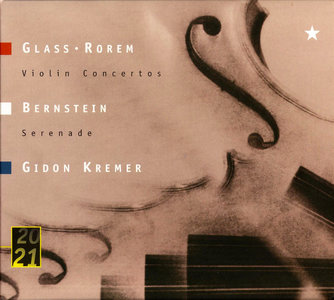Gidon Kremer - Philip Glass: Violin Concerto;
Ned Rorem: Violin Concerto; Leonard Bernstein: Serenade (1999)
EAC | FLAC | Image (Cue&Log) ~ 351 Mb | Mp3 (CBR320) ~ 183 Mb | Scans included
Genre: Classical | Label: Deutsche Grammophon | # 445 185-2 GH | Time: 01:18:30
Ned Rorem: Violin Concerto; Leonard Bernstein: Serenade (1999)
EAC | FLAC | Image (Cue&Log) ~ 351 Mb | Mp3 (CBR320) ~ 183 Mb | Scans included
Genre: Classical | Label: Deutsche Grammophon | # 445 185-2 GH | Time: 01:18:30
Here are three 20th-century violin concertos written within a 30-year period in three totally different styles, played by a soloist equally at home in all of them. Bernstein's Serenade, the earliest and most accessible work, takes its inspiration from Plato's Symposium; its five movements, musical portraits of the banquet's guests, represent different aspects of love as well as running the gamut of Bernstein's contrasting compositional styles. Rorem's concerto sounds wonderful. Its six movements have titles corresponding to their forms or moods; their character ranges from fast, brilliant, explosive to slow, passionate, melodious. Philip Glass's concerto, despite its conventional three movements and tonal, consonant harmonies, is the most elusive. Written in the "minimalist" style, which for most ordinary listeners is an acquired taste, it is based on repetition of small running figures both for orchestra and soloist, occasionally interrupted by long, high, singing lines in the violin against or above the orchestra's pulsation.



